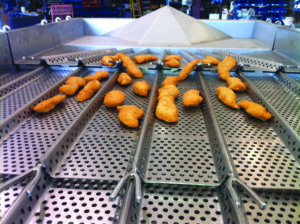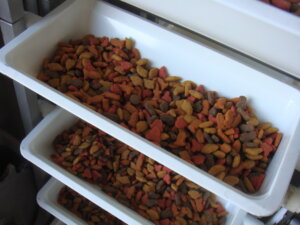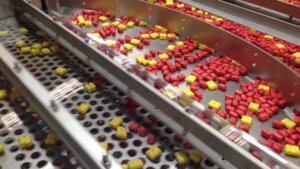As a food processor, you’ve built (or are building) a plant full of specialized machinery designed to prepare your product exactly how you want it.
Protect your investment by selecting a food conveyor system that maintains the quality and safety of your product.
Choosing low-cost or generic conveyor machinery may allow you to hit your productivity targets while keeping your project investment low.
However, damaged or poorly processed products and mounting maintenance bills will cost you more in the long run.
Worse, potential hygiene and food safety issues from using poorly designed or inappropriate equipment can cost your business millions and permanently damage your brand reputation.
Here, we look at how to choose safe, efficient food-grade conveyors that meet your company’s needs. We’ll lay out some key questions to consider as you work through the equipment procurement process and longer-term factors to remember.
We’ll also explain why partnering with an experienced, reputable food conveying solutions provider can help you get more value from your investment in conveying equipment.
SELECTING THE RIGHT FOOD CONVEYOR: 8 QUESTIONS
It’s tempting to see food conveying equipment as an “add-on” investment that just moves your ingredients and product where it needs to be for processing and packaging.
Smart manufacturers know that money spent on quality conveyor systems can add real value to your operation by helping protect and even enhance the quality of your products and the efficiency of your process.
It all starts with making wise, up-front decisions about the equipment you need and where you choose to source it. If you’re in the market for food-grade conveyor systems, here are nine key questions to consider when choosing the best solution.
1. Is It Really a Sanitary Conveyor?
Not all conveyors are designed specifically for handling foodstuffs. If you’re buying an off-the-shelf solution, be sure it is indeed a food-safe sanitary conveyor that can handle the elevated hygiene requirements that come with processing foods.
Look for conveyor designs that include:
- Materials that resist bacteria growth, like stainless steel and food-safe plastics
- Washdown-resistant materials and construction
- Sloped surfaces to drain water and limit condensation build-up
- Radiused corners and smooth, well-placed welds
- Tight tolerances and smooth joins to limit bacteria harboring
- Minimal food contact with fasteners, washers, or threads
If you’re handling foods that are particularly susceptible to bacterial contamination, like fresh meats or dairy, you’ll need to be sure that all food-contact surfaces on your conveyor are of stainless steel, and that its construction includes no hollow tubing that could harbor moisture.

For these applications, it’s also best to look for conveyors that meet the IP69K standard that ensures maximum water-tightness to better resist repeated high-temperature washdown and sanitation procedures.
2. Does It Meet (and Exceed) Food Safety Regulations?
In reality, whether a conveyor is suitable for handling food is not just up to you. If you’re considering buying a new or used conveyor, be sure to ask for proof that the equipment meets the minimum regulatory food safety and hygiene requirements for your application.
Depending on the planned application, true sanitary conveyors must meet a range of regulatory and industry standards. These include benchmarks determined by:
What’s more, regulations have evolved and become consistently tighter over time. That’s why many leading food manufacturers only buy equipment from suppliers whose equipment already exceeds the existing regulations and industry benchmarks.
3. Which Conveyor Type Is Best for My Product?
Different conveyor types move products differently. Belt, bucket and incline conveyors, tote dumpers, horizontal motion, and vibratory conveyors are all designed to solve particular food handling problems. But which one is right for you?
A lot depends on the specific handling requirements of your food products at any point in your process. Some key questions to ask include:
- What are the sanitary requirements of my product at this point in my process? These change as raw foods are processed into cooked, packaged products.
- What are the handling characteristics of your food at this point? Are foodstuffs frozen, raw, or cooked? Solid or liquid? Fine or granular? Hot or cold? Oily, waxy, or sticky? Large, small, or irregularly shaped? Are they fragile or susceptible to bruising?
- Does your product require handling or processing while being conveyed? Do foodstuffs need to be cooled, heated, or frozen? Do they need to be dewatered or dried, graded, screened, or positioned? Do products need to be mixed at a set ratio?
- What are the physical constraints of this production zone? This might include the maximum space available, distance to the next line process, and necessary changes in height or direction.
- How will my conveying equipment integrate with other equipment? Custom modifications might be required to allow one or more OEM units to work together.
The answers to these questions will narrow your options. For example, raw and frozen meats and dairy products may require vibratory or horizontal motion conveyors with the highest level of sanitary protection, while packaging operations may require less. In addition:
- Conventional belt conveyors are a versatile choice for many foods from grains and dry bulk ingredients to baked products, produce, and packaged goods. Belt conveyors are also the preferred choice for precise food placement for pick-and-place applications.
- Horizontal motion conveyors are not suitable for fine materials but are effective at moving frozen foods and hard, granular products like pasta. Their gentle, gliding motion also makes them the go-to choice for delicate or seasoned items like snacks or pastries.
- Vibratory conveyors are effective for moving small or powdery products like nuts and grains and delicate items like chocolates. The controlled agitation of these machines is also good for dewatering, grading, screening, or mixing of foods while in transit.
Be aware, though, that the physical constraints of your process or plant may also affect which conveyor you choose. Belt, horizontal motion, and vibratory conveyors can raise and lower product within limits, but significant height changes will require a bucket elevator conveyor system.
Belt and vibratory conveyors move foods at a steady rate and are preferred where foods need to be heated, cooled, dried, or frozen while in transit. Horizontal motion conveyors allow many food products to be visually inspected while moving through the final stages of production.
Horizontal motion and, to some extent, vibratory conveyors are constrained in the lengths individual machines can cover. It may take a series of several units to cover the same distance that a single belt conveyor could span.
With so many factors in play, it’s important to choose a reputable sanitary equipment supplier offering the full range of conveying options. Only leading brand manufacturers have the experience and engineering expertise to:
4. Will My Conveyor Deliver the Throughput and Capacity I Need?
With all of the details in place, it’s time to assess whether the technology, customizations, and integrations you have put in place are going to deliver the daily throughput and overall line capacity you need.
Some conveyors are available in wider belt or pan configurations to boost capacity, while variable speed equipment (such as many horizontal motion models) allows you to fine-tune throughput according to your changing needs.
Better integration with existing equipment will normally also help boost overall line capacity. That said, if a given piece of equipment is not able to deliver the raw capacity you need on your line, you may need to reconsider your options.
5. What About Customization Options?
Different customization options can allow conveyors to be used for dramatically different applications.
Adding non-stick pans to horizontal motion conveyors allows them to be used to handle greasy or sticky foods in the final stages of processing while using specially designed screens on vibratory conveyors allows them to be used to drain dipped or fried foods.
There’s no substitute for experience in understanding how different types of foodstuffs act when handled in bulk. That’s why it’s best to work with a food conveyor equipment specialist to identify the best mix of technology and customization for your operation.
6. Will It Fit My Plant Configuration?
The preferred handling technology for your product must be balanced against the realities of your plant and line setup.
For example, bucket elevators or incline belt conveyors are the go-to solution when a product must be moved up or down more than just a few feet, while U-shaped curved conveyors are used to move around structures and equipment or add cooling loops into a line.

You might also need to plan for system support infrastructure like adjacent mezzanines and catwalks.
7. Will It Integrate With My Existing Equipment?
Additionally, your new conveying equipment must link as seamlessly as possible with your existing line equipment. Consider the speed and temperatures at which different pieces of equipment operate and the height and width of the entry and exit points to make sure they will align with your current system.
Also, consider whether your equipment will need to work with:
- Customized infeed and discharge modifications
- Specialized safety requirements like vision, metal-detecting, and X-ray equipment
- Process-specific options like clean-in-place systems, gates, or belt scrapers
- Safety equipment such as emergency stops, cut-offs, and failsafes
Clearly, there is more to choosing a conveyor system than picking out a standalone piece of equipment. It’s essential to work with experts who can take a “whole plant” approach to help you plan how a conveyor will both meet and enhance your system integration.
8. How Much Will It Cost?
Finally, consider the upfront sticker price for a food-grade conveyor system. Is it within your project budget, and will the added capacity of your operation or the improved quality of your product justify the expense of purchasing, integrating, and commissioning the new equipment?
ADDING PROCESSING VALUE DOWN THE LINE
There is, however, more to choosing a food-grade conveyor system than upfront performance and cost.
While the above questions will help ensure the conveyor system you choose meets your minimum requirements, it’s important to look at factors that affect the long-term value that food conveying equipment will bring to your company.
1. Durability
The lower price you might pay for generic or off-the-shelf conveying solutions might start to look expensive if you find yourself having to replace equipment within just a few years.
You’ll pay more upfront for a premium conveying solution customized to your specific needs, but you’ll also get more value for your money, including:
- More sanitary, longer-lasting materials
- Better equipment design, often with fewer moving parts
- Conveyors designed to work with your product and process
This can mean a food-conveying system that delivers safety and efficiency for decades rather than just a few years, making your initial investment more valuable as time goes on.
2. Reliability
Higher quality equipment also runs better for longer, thereby boosting productivity and saving you money on downtime and maintenance. Leading brand equipment is designed to operate longer between services and to be easier to maintain.
Consumable components and parts like belts, vibratory springs, and dumper cylinders are also easier to access and quicker to switch out on true professional-grade equipment—meaning your line is up and running sooner.
3. Safety & Sanitary
Quality food-grade conveyor systems are designed specifically for your application and process. This protects your staff from workplace accidents resulting from inappropriate handling techniques or poor integration with other equipment.
It also makes equipment easier to keep clean. Better-designed equipment is easier to strip down to wash and features fewer rough or exposed surfaces, such as bolt threads or panel joins. At the same time, this equipment has higher-quality welding, making surfaces easier to swab for food safety.
Premium equipment also allows more regular maintenance to be performed without tools. This helps keep non-sanitary equipment off your line and reduces the likelihood of scratches or dents on food-exposed surfaces that could potentially harbor bacteria.
4. Value-Added Conveying
Food conveyors that are built with your process and application in mind also offer long-term value in other ways.
Integrated conveyor systems designed by a single supplier are easier to upgrade and expand as your business grows and develops. It’s easier to increase capacity and add functionality to equipment that comes from the same vendor.
It’s also possible to build more functionality into equipment that can be customized to your specific needs.

For example, professional-grade vibratory conveyors can be designed to reorientate, spread, grade, and even separate materials on the go. They can even dewater washed products or allow cooked foods to cool while in motion, allowing you to reduce or even eliminate processing steps.
5. Vendor Experience
This value-added flexibility and functionality is only available, however, when you work with a professional food conveyor supplier capable of delivering solutions tailored to your needs. It also helps to partner with a company with extensive experience in the same food sector you work in.
These dedicated suppliers offer extensive experience in best practices of food handling and processing you won’t find elsewhere, and the skills needed to put this knowledge to work.
In fact, across the food processing industry, while sector newcomers tend to look for the lowest price when sourcing conveying equipment, established players prefer to use equipment provided by one of just a few trusted suppliers.
6. After-Sales Service
There’s also a big difference in the levels of service provided by dedicated, established food conveyor equipment makers and more generic suppliers. For maximum return on your investment, look for a vendor that stands behind their equipment after the sale is completed.
The best suppliers follow through on the work done to design and customize your equipment by ensuring the equipment is properly installed and your staff is fully trained.
Look also for companies that provide:
Of course, not all equipment providers have the scale and experience to provide this level of ongoing support. If you’re looking for a food conveyor partner for the long haul, make sure to find one that meets this criteria.
PFI: YOUR PREFERRED FOOD CONVEYOR SYSTEMS PROVIDER
If you’re a project manager overseeing a plant build-out or line upgrade, conveying equipment might be one of the last items on your list. But don’t let your food conveyor system become the weak link in your business’s value chain.
Not only can skimping on the connections between your processes cost you more down the road, but you could be missing out on opportunities to add value to your operation by simplifying, streamlining, and combining steps into a single, seamlessly integrated whole.
PFI is a global leader in providing best-in-class sanitary conveying solutions that meet and exceed leading regulatory and industry food safety standards. With extensive experience across the food-processing sector, we are a trusted partner to many of the world’s leading food brands.
We have the knowledge and experience to help you find the best sanitary conveying solutions for your food processing needs plus the skills, scale, and dedication to deliver it to your exact specifications and support it for years—or decades—to come.
Learn more about our industry-leading sanitary equipment or contact us directly today.
See Our Food-Grade Conveyors
Get Expert Help
![]()
![]()
![]()
![]() Maintaining hygiene and product integrity is paramount in food processing. Their sanitary design meets these stringent requirements. One-piece, smooth pans with angled side edges eliminate areas where a product can build up or become contaminated.
Maintaining hygiene and product integrity is paramount in food processing. Their sanitary design meets these stringent requirements. One-piece, smooth pans with angled side edges eliminate areas where a product can build up or become contaminated.










